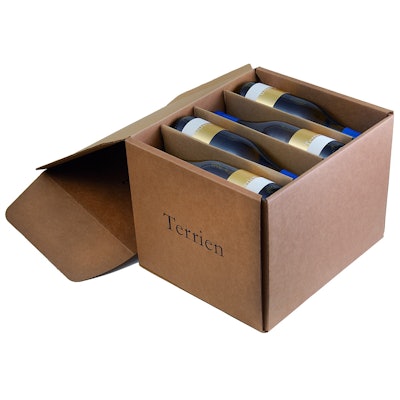From one perspective, it’s all about energy. Where are the sources of energy waste that can be eliminated from the system?
Because sustainability is still not a primary driver for many brands, suppliers have to push hard to promote options that are both better for the environment and better for the bottom line. One positive that offers some hope is that consumers seem to appreciate sustainability gains such as lightweighting and recycled content, and brands can build sustainability into their core values. Here are some more tips on how to start thinking about more efficient systems.
1. Establish a standard for yourself. Consult a testing lab, university, or nonprofit organization to both benchmark your current practices and discover opportunities to improve. At the minimum, itemize energy use, supply costs, material sources, and waste disposal costs to have a starting point. A comprehensive Life Cycle Analysis or a variation of a packaging sustainability scorecard is also useful when approaching retailers with your products and packages. For many fast-moving consumer goods, the bottom-line goal is simply fewer truck miles.
2. Right-size primary packaging. Whenever possible, work with product development to right-size the product in conjunction with the package. Consider both product and packaging as a system to maximize the quantity of product units, or case units, that can fit onto a pallet.
3. Be product and material neutral, or “agnostic.” Realize that vendors you consult will have their own biases, preferences, and interests in steering you in a particular direction. Focus on optimization of high performance with minimal materials, regardless of the substrate. But be practical. Study how packages are actually used. And remember stock components can have strong supply chain advantages because of availability, low minimums, and consistency.
4. Recognize the importance of production line speeds. Nothing impacts the bottom-line profitability of a fast-moving consumer good more than if it can’t be mass-produced, labeled, or filled quickly. For instance, the metal cans versus plastic cans equation comes down to the fact that plastic cans still cannot keep up with metal cans during the filling process because plastic cans cannot achieve the same high speeds. Similarly, the softness and pliability of flexible pouch materials do not stand up to the high-speed machine handling that would make them more cost-efficient.
5. Reduce or eliminate secondary shipping packaging. Well-designed primary packaging and shrink wrap can reduce shipping packaging significantly. For instance, some CPGs are upping their SBS from .16 to .22 or .24 so they can eliminate secondary cases or other pallet support packaging. Take advantage of volume savings. Saving 1/16 in. or
1/8 in. on height or width can result in substantial savings across product lines. And consider all the products that need packaging, not just the core product line. Potential cost and waste savings can be quickly estimated by quantifying exactly what is being shipped and how much excessive packaging is being used.
6. Understand how supply chains differ. Commodity materials are more accessible than “rare” sustainable or biodegradable materials. Suppliers would do well to create smaller plants in distinct regions to respond to this shift in the supply chain. Shortening the distance to source materials and identifying manufacturing facilities close to distribution channels are two quick wins for improving sustainability scores.
7. Combine packaging configurations. Learn about all the different packaging scenarios and all the possible configurations that you ship. Optimize ordering processes and warehouse management to reduce over-packaging. Many order systems are complicated. Get the IT department involved to develop a plan to rationalize the number of packaging sizes and combine shipments whenever possible. Reduce the number of SKUs to streamline shipping and conquer complexity in the warehouse.
8. Use case- and pallet-maximizing software. As already mentioned, trimming fractions of an inch here or there can result in significant supply chain savings. The more you understand how your products and packages work together in different environments, the more you can plan ahead in development. Be prepared for the possibility, though, that the software analysis may suggest changing the dimensions of the product itself.
9. Explore multiple-use or closed-loop packaging. Explore ways a shipping package can be used multiple times for the same function or can be used for another function before being discarded. The cost of the product goes down with each time it is used, but don’t forget to estimate and factor in a management cost with reused, recycled, or multiple-use packaging. Companies are often surprised at how much “internal” packaging they use and how easily it can be converted into reusable containers that have virtually unlimited life cycles.
10. Know the capabilities with recycled-content packaging. Using recycled-content paper-based packaging may in some cases result in limited availability, higher cost, or lower package strength depending on the application and design. Where that may not be the case is with recycled-content corrugated board, which has a false reputation of being less strong. Corrugated board is rated for strength, so all you need to do is request the ECT test rating on whatever edge-crush resistance you need in relation to the percentage of recycled content you’re looking for. And it’s not always more expensive either.
11. Avoid myopia about impacts. Measure the total costs of the disposal of both recycled content and waste. Consolidate packaging teams with engineering, design, sourcing, and marketing staff to optimize the performance of packaging from the back end to the front end. Determine strategies based on what is reasonable for your product and operations, and forecast future impacts as operations scale up. And be mindful, some sustainability goals and strategies can work against each other.
12. Keep goals attainable and marketable. Minimizing your company’s carbon footprint may be laudable, but it can be difficult to measure and difficult to communicate to consumers. Whereas using only recycled materials is both achievable and a simple message to convey. It’s important to educate the public that packaging is not a cost; it’s an integrated component of the supply chain. With marketing campaigns, it’s essential to hit all the brand and packaging touchpoints with a unified, consistent message.
13. Keep it local. Shipping packages that are mostly air over short distances is bad enough, but carbon footprints get multiplied quickly over the longer distances that products often travel these days. Identify suppliers that share your mission. Research suppliers deeply, because they may have their own business model that is not completely compatible with yours. You might find that they have an advantage in one area, but not in all the systems or in all the geographic locations where they operate.
14. Account for all possible sources of material waste. Be prepared to answer questions from customers and retailers about how much waste they can expect. More end users are weighing disposal costs carefully and demanding less waste overall. Look into the vast array of recover, reuse, recycling, and recall systems available today.
15. Distinguish between suppliers and partners. Determine which suppliers would serve you better as partners. Not every supplier should be a partner. It’s okay to use both, but partners can grow organically with your company as it grows. Expect suppliers to perform at a high level, introduce new value, and become more efficient over time. It’s never too late to shop around for more responsive suppliers.
Liked this article? Download the entire playbook here.


























